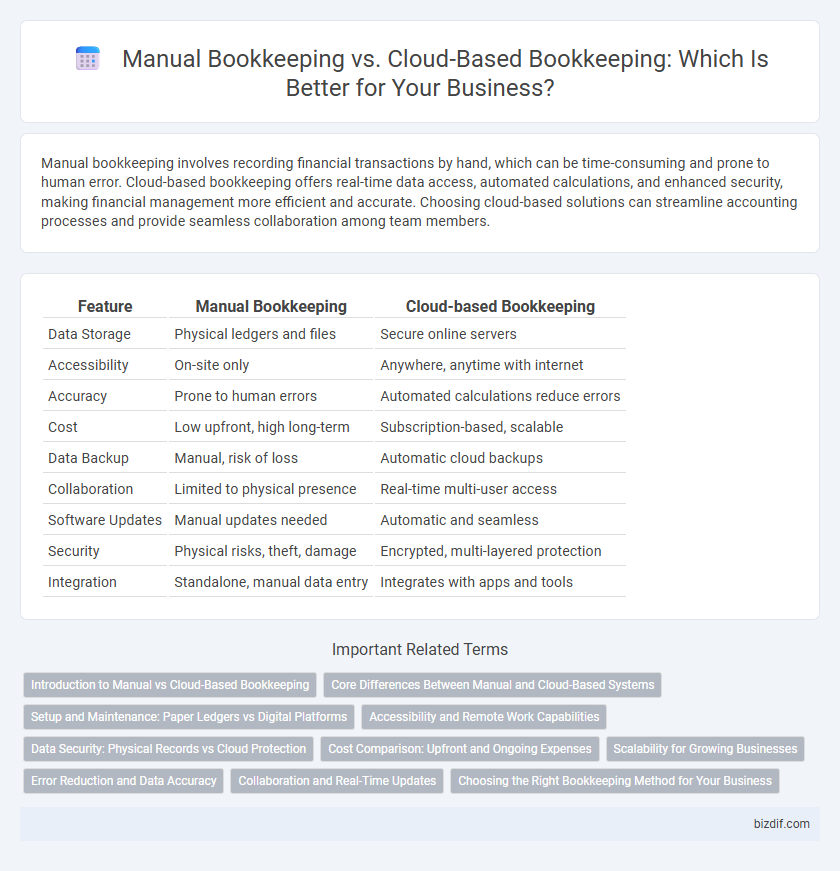Manual bookkeeping involves recording financial transactions by hand, which can be time-consuming and prone to human error. Cloud-based bookkeeping offers real-time data access, automated calculations, and enhanced security, making financial management more efficient and accurate. Choosing cloud-based solutions can streamline accounting processes and provide seamless collaboration among team members.
Table of Comparison
| Feature | Manual Bookkeeping | Cloud-based Bookkeeping |
|---|---|---|
| Data Storage | Physical ledgers and files | Secure online servers |
| Accessibility | On-site only | Anywhere, anytime with internet |
| Accuracy | Prone to human errors | Automated calculations reduce errors |
| Cost | Low upfront, high long-term | Subscription-based, scalable |
| Data Backup | Manual, risk of loss | Automatic cloud backups |
| Collaboration | Limited to physical presence | Real-time multi-user access |
| Software Updates | Manual updates needed | Automatic and seamless |
| Security | Physical risks, theft, damage | Encrypted, multi-layered protection |
| Integration | Standalone, manual data entry | Integrates with apps and tools |
Introduction to Manual vs Cloud-Based Bookkeeping
Manual bookkeeping involves recording financial transactions by hand using physical ledgers, offering direct control but requiring significant time and effort. Cloud-based bookkeeping utilizes online software to automate data entry and storage, enabling real-time access, enhanced accuracy, and secure backups. Businesses increasingly prefer cloud solutions for scalability, integration with other financial tools, and remote accessibility.
Core Differences Between Manual and Cloud-Based Systems
Manual bookkeeping relies on physical ledgers and handwritten records, making data entry time-consuming and error-prone. Cloud-based bookkeeping utilizes online software with real-time data access, automated calculations, and seamless integration with other business tools. Core differences include accessibility, accuracy, and efficiency, as cloud systems enable remote collaboration and instant updates, unlike manual methods.
Setup and Maintenance: Paper Ledgers vs Digital Platforms
Manual bookkeeping relies on paper ledgers that require physical setup, frequent organization, and manual entries, leading to time-consuming maintenance and higher risk of human error. Cloud-based bookkeeping platforms offer automated setup, real-time data synchronization, and regular software updates, streamlining maintenance and enhancing accuracy. Digital platforms also provide secure backup and easy scalability, reducing administrative burden compared to traditional paper-based systems.
Accessibility and Remote Work Capabilities
Cloud-based bookkeeping platforms offer superior accessibility by enabling real-time data entry and retrieval from any location with internet access, which is essential for remote work environments. Manual bookkeeping requires physical presence and access to paper records or local systems, limiting flexibility and slowing collaboration among distributed teams. Businesses adopting cloud-based solutions benefit from seamless synchronization and enhanced security features tailored for remote operations.
Data Security: Physical Records vs Cloud Protection
Manual bookkeeping relies on physical records stored on-site, making data vulnerable to theft, damage, or loss due to fire or natural disasters. Cloud-based bookkeeping uses encrypted servers with multi-factor authentication and regular backups to enhance data security and ensure continuity. Cloud protection also allows automatic updates and real-time monitoring, reducing risks of unauthorized access compared to traditional physical storage.
Cost Comparison: Upfront and Ongoing Expenses
Manual bookkeeping involves significant upfront costs such as purchasing physical ledgers, accounting software licenses, and office supplies, with ongoing expenses including printing, storage, and labor-intensive data entry. Cloud-based bookkeeping typically requires lower initial investment, often structured as monthly or annual subscription fees, which cover software updates, data security, and online support. Over time, cloud-based solutions reduce ongoing operational costs by automating processes and eliminating the need for physical materials and extensive manual labor.
Scalability for Growing Businesses
Manual bookkeeping limits scalability for growing businesses due to its reliance on physical records and labor-intensive processes, which increase the risk of errors and inefficiencies as transaction volumes rise. Cloud-based bookkeeping offers seamless scalability with automated data entry, real-time updates, and easy access to financial records, enabling businesses to handle expanding operations without additional overhead. Integration with other cloud services further supports business growth by streamlining workflows and enhancing financial decision-making.
Error Reduction and Data Accuracy
Manual bookkeeping often leads to higher error rates due to human mistakes in data entry and calculations, impacting overall data accuracy. Cloud-based bookkeeping leverages automated processes and real-time data validation to significantly reduce errors and enhance accuracy. Secure cloud platforms also enable seamless collaboration and instant updates, minimizing discrepancies and ensuring consistent financial records.
Collaboration and Real-Time Updates
Manual bookkeeping limits collaboration by restricting access to physical records, causing delays in data sharing and error correction. Cloud-based bookkeeping enables multiple users to access and update financial information simultaneously, ensuring real-time updates and improved accuracy. This seamless collaboration enhances decision-making and streamlines financial management for businesses.
Choosing the Right Bookkeeping Method for Your Business
Choosing the right bookkeeping method for your business depends on factors such as budget, scalability, and data security. Manual bookkeeping offers hands-on control and lower initial costs but requires more time and is prone to human errors. Cloud-based bookkeeping provides real-time access, automated updates, and secure data backup, making it ideal for growing businesses seeking efficiency and accuracy.
Manual Bookkeeping vs Cloud-based Bookkeeping Infographic

 bizdif.com
bizdif.com